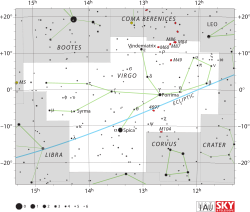|
| Ypsilon Virginis (υ) |  | Observationsdata
Epok: J2000.0 |
|---|
| Stjärnbild | Jungfrun |
|---|
| Rektascension | 14t 19m 32,48100s[1] |
|---|
| Deklination | 02° 15′ 55,8637″[1] |
|---|
Skenbar magnitud ( ) ) | 5,27[2] |
|---|
| Stjärntyp |
|---|
| Spektraltyp | G9 III[3] |
|---|
| U–B | +0,81[2] |
|---|
| B–V | +1,023[4] |
|---|
| Astrometri |
|---|
Radialhastighet ( ) ) | -26,68 ± 0,16[4] km/s |
|---|
| Egenrörelse (µ) | RA: -117,33[1] mas/år
Dek.: -71,62[1] mas/år |
|---|
Parallax ( ) ) | 12,47 ± 0,31[1] |
|---|
| Avstånd | 262 ± 7 lå (80 ± 2 pc) |
|---|
Absolut magnitud ( ) ) | +0,4[3] |
|---|
| Detaljer |
|---|
| Massa | 1,72 [5] M☉ |
|---|
| Radie | 12 R☉ |
|---|
| Luminositet | 64,6[4] L☉ |
|---|
| Temperatur | 4 753[4] K |
|---|
| Metallicitet | -0,22 |
|---|
| Vinkelhastighet | 3,4 km/s |
|---|
| Andra beteckningar |
|---|
| Υ Vir, 102 Virginis, BD-01° 2938, FK5 3134, HD 125454, HIP 70012, HR 5366, SAO 139866.[6] |
Ypsilon Virginis ( υ Virginis, förkortat Ypsilon Vir, υ Vir) som är stjärnans Bayerbeteckning, är en ensam stjärna[7] belägen i östra delen av stjärnbilden Jungfrun. Den har en skenbar magnitud på +5,25[2] och är svagt synlig för blotta ögat. Baserat på parallaxmätning inom Hipparcosuppdraget på 12,5 mas,[1] beräknas den befinna sig på ett avstånd av ca 262 ljusår (80 parsek) från solen.
Egenskaper
Ypsilon Virginis är en vit till gul stjärna av spektralklass G9 III,[3] vilket anger att den är en utvecklad jättestjärna. Den har en massa som är 1,7 gånger så stor som solens och en radie som är 12 gånger solens radie. Den utsänder från sin yttre atmosfär 65[4] gånger mer energi än solen vid en effektiv temperatur på ca 4 750[4] K. Ypsilon Virginis roterar med en låg prognostiserad rotationshastighet på endast 3,4 km/s. Baserat på dess rörelse genom rymden finns det 66 procent sannolikhet att stjärnan är en medlem i Herculesströmmen och 27 procent sannolikhet att den är en tunn diskstjärna.[8]
Källor
- Den här artikeln är helt eller delvis baserad på material från engelskspråkiga Wikipedia, tidigare version.
Referenser
- ^ [a b c d e f] van Leeuwen, F. (November 2007), "Validation of the new Hipparcos reduction", Astronomy and Astrophysics, 474 (2): 653–664, Bibcode:2007A&A...474..653V, arXiv:0708.1752 Freely accessible, doi:10.1051/0004-6361:20078357.
- ^ [a b c] Mermilliod, J.-C. (1986), Compilation of Eggen's UBV data, transformed to UBV (unpublished), SIMBAD, Bibcode:1986EgUBV........0M.
- ^ [a b c] Takeda, Yoichi; et al. (August 2008), "Stellar Parameters and Elemental Abundances of Late-G Giants", Publications of the Astronomical Society of Japan, 60 (4): 781–802, Bibcode:2008PASJ...60..781T, arXiv:0805.2434 Freely accessible, doi:10.1093/pasj/60.4.781.
- ^ [a b c d e f] Massarotti, Alessandro; et al. (January 2008), "Rotational and radial velocities for a sample of 761 HIPPARCOS giants and the role of binarity", The Astronomical Journal, 135 (1): 209–231, Bibcode:2008AJ....135..209M, doi:10.1088/0004-6256/135/1/209.
- ^ Luck, R. Earle; Heiter, Ulrike (June 2007), "Giants in the Local Region", The Astronomical Journal, 133 (6): 2464–2486, Bibcode:2007AJ....133.2464L, doi:10.1086/513194.
- ^ "ups Vir -- Variable Star", SIMBAD Astronomical Database, Centre de Données astronomiques de Strasbourg, hämtad 2016-09-18.
- ^ Eggleton, P. P.; Tokovinin, A. A. (September 2008), "A catalogue of multiplicity among bright stellar systems", Monthly Notices of the Royal Astronomical Society, 389 (2): 869–879, Bibcode:2008MNRAS.389..869E, arXiv:0806.2878 Freely accessible, doi:10.1111/j.1365-2966.2008.13596.x.
- ^ Soubiran, C.; et al. (March 2008), "Vertical distribution of Galactic disk stars. IV. AMR and AVR from clump giants", Astronomy and Astrophysics, 480 (1): 91–101, Bibcode:2008A&A...480...91S, arXiv:0712.1370 Freely accessible, doi:10.1051/0004-6361:20078788.
Externa länkar
|





